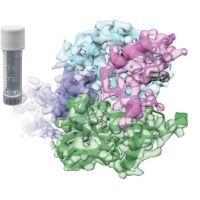Specification
| Description | Recombinant protein from the full-length sequence of Homo sapiens pleckstrin homology like domain family A member 2 (PHLDA2) (NM_003311). |
| Organism | Homo sapiens (Human) |
| Expression Host | Human Cells |
| Tag Info | His or DYKDDDDK. Please contact us if you need further information or require specific designed tag. |
| Purity | Greater than 90% by SDS-PAGE gel |
| Uniprot ID | Q53GA4 |
| Entry Name | PHLA2_HUMAN |
| Gene Names | PHLDA2 BWR1C HLDA2 IPL TSSC3 |
| Alternative Gene Names | BWR1C HLDA2 IPL TSSC3 |
| Alternative Protein Names | Pleckstrin homology-like domain family A member 2 (Beckwith-Wiedemann syndrome chromosomal region 1 candidate gene C protein) (Imprinted in placenta and liver protein) (Tumor-suppressing STF cDNA 3 protein) (Tumor-suppressing subchromosomal transferable fragment candidate gene 3 protein) (p17-Beckwith-Wiedemann region 1 C) (p17-BWR1C) |
| Application | Antigens, Western, ELISA and other in vitro binding or in vivo functional assays, and protein-protein interaction studies; For research & development use only! |
| Buffer | Purified protein formulated in a sterile solution of PBS buffer, pH7.2, without any preservatives |
| Endotoxin | Endotoxin level is < 0.1 ng/µg of protein (<1EU /µg) |
| Length | 152 |
| Molecular Weight(Da) | 17092 |
| Protein Sequence | (The sequence of expressed protein may have some variation from the sequence shown below. Please contact us for the exact sequence.) MKSPDEVLREGELEKRSDSLFQLWKKKRGVLTSDRLSLFPASPRARPKELRFHSILKVDCVERTGKYVYFTIVTTDHKEIDFRCAGESCWNAAIALALIDFQNRRALQDFRSRQERTAPAAPAEDAVAAAAAAPSEPSEPSRPSPQPKPRTP |
Background
| Function | FUNCTION: Plays a role in regulating placenta growth. May act via its PH domain that competes with other PH domain-containing proteins, thereby preventing their binding to membrane lipids (By similarity). {ECO:0000250}. |
| Pathway | |
| Protein Families | PHLDA2 family |
| Tissue Specificity | Expressed in placenta and adult prostate gland. In placenta, it is present in all cells of the villous cytotrophoblast. The protein is absent in cells from hydatidiform moles. Hydatidiform mole is a gestation characterized by abnormal development of both fetus and trophoblast. The majority of hydatidiform moles are associated with an excess of paternal to maternal genomes and are likely to result from the abnormal expression of imprinted genes (at protein level). Expressed at low levels in adult liver and lung, and fetal liver. Expressed in adult brain and neuroblastoma, medullablastoma and glioblastoma cell lines. {ECO:0000269|PubMed:10594239, ECO:0000269|PubMed:10749982, ECO:0000269|PubMed:13129680, ECO:0000269|PubMed:15457853, ECO:0000269|PubMed:9328465}. |
QC Data
| Note | Please contact us for QC Data |
| Product Image (Reference Only) |  |

